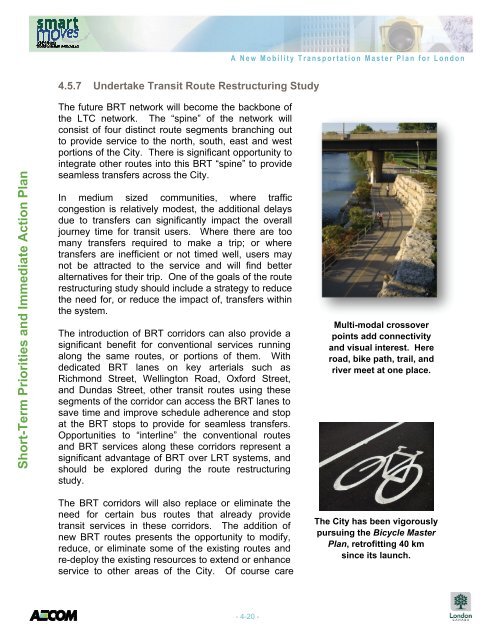A New Mobility Transportation Master Plan for London
A New Mobility Transportation Master Plan for London
A New Mobility Transportation Master Plan for London
You also want an ePaper? Increase the reach of your titles
YUMPU automatically turns print PDFs into web optimized ePapers that Google loves.
Short-Term Priorities and Immediate Action <strong>Plan</strong><br />
4.5.7 Undertake Transit Route Restructuring Study<br />
The future BRT network will become the backbone of<br />
the LTC network. The “spine” of the network will<br />
consist of four distinct route segments branching out<br />
to provide service to the north, south, east and west<br />
portions of the City. There is significant opportunity to<br />
integrate other routes into this BRT “spine” to provide<br />
seamless transfers across the City.<br />
In medium sized communities, where traffic<br />
congestion is relatively modest, the additional delays<br />
due to transfers can significantly impact the overall<br />
journey time <strong>for</strong> transit users. Where there are too<br />
many transfers required to make a trip; or where<br />
transfers are inefficient or not timed well, users may<br />
not be attracted to the service and will find better<br />
alternatives <strong>for</strong> their trip. One of the goals of the route<br />
restructuring study should include a strategy to reduce<br />
the need <strong>for</strong>, or reduce the impact of, transfers within<br />
the system.<br />
The introduction of BRT corridors can also provide a<br />
significant benefit <strong>for</strong> conventional services running<br />
along the same routes, or portions of them. With<br />
dedicated BRT lanes on key arterials such as<br />
Richmond Street, Wellington Road, Ox<strong>for</strong>d Street,<br />
and Dundas Street, other transit routes using these<br />
segments of the corridor can access the BRT lanes to<br />
save time and improve schedule adherence and stop<br />
at the BRT stops to provide <strong>for</strong> seamless transfers.<br />
Opportunities to “interline” the conventional routes<br />
and BRT services along these corridors represent a<br />
significant advantage of BRT over LRT systems, and<br />
should be explored during the route restructuring<br />
study.<br />
The BRT corridors will also replace or eliminate the<br />
need <strong>for</strong> certain bus routes that already provide<br />
transit services in these corridors. The addition of<br />
new BRT routes presents the opportunity to modify,<br />
reduce, or eliminate some of the existing routes and<br />
re-deploy the existing resources to extend or enhance<br />
service to other areas of the City. Of course care<br />
A <strong>New</strong> <strong>Mobility</strong> <strong>Transportation</strong> <strong>Master</strong> <strong>Plan</strong> <strong>for</strong> <strong>London</strong><br />
- 4-20 -<br />
Multi-modal crossover<br />
points add connectivity<br />
and visual interest. Here<br />
road, bike path, trail, and<br />
river meet at one place.<br />
The City has been vigorously<br />
pursuing the Bicycle <strong>Master</strong><br />
<strong>Plan</strong>, retrofitting 40 km<br />
since its launch.


